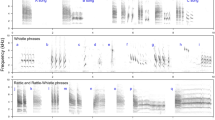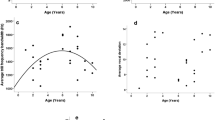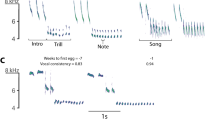Abstract
Considerable debate surrounds the functional and evolutionary significance of the complex song repertoires found in male passerine birds1–3. A comparative study on European warblers of the genus Acrocephalus4 has suggested that sexual selection is the driving force behind the evolution of the extraordinary song complexity in this group. One species in particular, the sedge warbler Acrocephalus schoenobaenus, sings long, variable, continuous songs constructed from a repertoire of discrete building blocks called syllables, revealed by sonagraphic analysis5. Although a strong inverse correlation between male repertoire size and pairing date was obtained from this wild population of sedge warblers, it was difficult to control adequately for confounding variables of male or territory quality which may also influence female choice at the time of pairing. It has been demonstrated recently that female songbirds implanted with oestradiol respond to playback of recorded song in laboratory conditions6–10; the resulting displays have been used as an index of response to a variety of natural and experimental songs. Here we have used both natural recordings from an earlier field study and experimental songs to demonstrate that implanted female sedge warblers respond significantly more to playback of higher repertoire sizes in standard laboratory conditions.
This is a preview of subscription content, access via your institution
Access options
Subscribe to this journal
Receive 51 print issues and online access
$199.00 per year
only $3.90 per issue
Buy this article
- Purchase on SpringerLink
- Instant access to full article PDF
Prices may be subject to local taxes which are calculated during checkout
Similar content being viewed by others
References
Catchpole, C. K. in Acoustic Communication in Birds Vol. 1 (eds Kroodsma, D. E. & Miller, E. H.) 297–319 (Academic, New York, 1982).
Krebs, J. R. & Kroodsma, D. E. Adv. Stud. Behav. 11, 143–177 (1980).
Slater, P. J. B. Z. Tierpsychol. 56, 1–24 (1981).
Catchpole, C. K. Behaviour 74, 149–166 (1980).
Catchpole, C. K. Behaviour 59, 226–246 (1976).
Baker, M., Spitler-Nabors, K. & Bradley, D. Science 214, 819–821 (1981).
Searcy, W. & Marler, P. Science 213, 926–928 (1981).
Searcy, W., Marler, P. & Peters, S. Anim. Behav. 29, 997–1003 (1981).
Searcy, W., Searcy, M. & Marler, P. Behaviour 80, 70–83 (1982).
Searcy, W. Behav. Ecol. Sociobiol. 14, 281–286 (1984).
Author information
Authors and Affiliations
Rights and permissions
About this article
Cite this article
Catchpole, C., Dittami, J. & Leisler, B. Differential responses to male song repertoires in female songbirds implanted with oestradiol. Nature 312, 563–564 (1984). https://doi.org/10.1038/312563a0
Received:
Accepted:
Issue date:
DOI: https://doi.org/10.1038/312563a0
This article is cited by
-
What is the whistle all about? A study on whistle songs, related male characteristics, and female song preferences in common nightingales
Journal of Ornithology (2016)
-
The influence of phenology on double-brooding and polygyny incidence in the Sedge Warbler Acrocephalus schoenobaenus
Journal of Ornithology (2015)
-
Darwin’s “tug-of-war” vs. starlings’ “horse-racing”: how adaptations for sequential encounters drive simultaneous choice
Behavioral Ecology and Sociobiology (2011)
-
Spatial and age-related variation in use of locally common song elements in dawn singing of song sparrows Melospiza melodia: old males sing the hits
Behavioral Ecology and Sociobiology (2011)
-
Operant conditioning and copulation solicitation display assays reveal a stable preference for local song by female swamp sparrows Melospiza georgiana
Behavioral Ecology and Sociobiology (2009)



